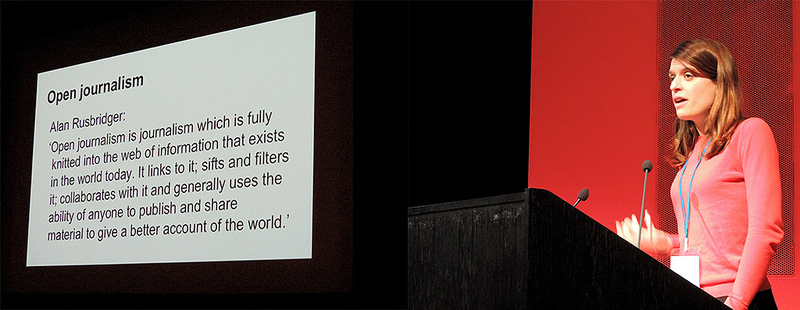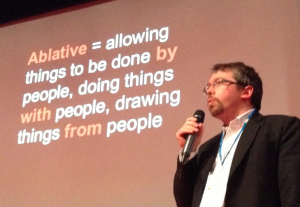MCG's UK Museums on the Web 2013: 'Power to the people' was held at Tate Modern on November 15, 2013. These are very selected notes but you can find out more about the sessions and see most slides on the MCG's site. UKMW13 began with a welcome from me (zzz) and from Tate's John Stack (hoorah!) then an announcement from our sponsors, Axiell Adlib and CALM, that CALM, Mimsy and AdLib are merging to create 'next generation' collections system – the old school collections management geek in me is really curious to see what that means for museums, libraries and archives and their data.
Our first keynote, Hannah Freeman, presented on the Guardian's work to reach and engage new audiences. This work is underpinned by editor Alan Rusbridger's vision for 'open journalism':
'journalism which is fully knitted into the web of information that exists in the world today. It links to it; sifts and filters it; collaborates with it and generally uses the ability of anyone to publish and share material to give a better account of the world'.
At a casual glance the most visible aspect may be comments on pages, but the Guardian is aiming for collaborations between the reader and the newsroom – if you haven't seen Guardian Witness, go check it out. (I suspect the Witness WWI assignment will do better than many heritage crowdsourcing efforts.) I know some museums are aiming to be of the web, not just on the web, but this ambition is usually limited to making their content of the web, while a commitment to open journalism suggests that the very core practices of journalism are open to being shaped by the public.
The Guardian is actively looking for ways to involve the audience; Freeman prompts editors and authors to look at interesting comments, but 'following as well as leading is a challenge for journalists'. She said that 'publication can be the beginning, not the end of the process' and that taking part in the conversation generated is now part of the deal when writing for the Guardian (possibly not all sections, and possibly staff journalists rather than freelancers?). From a reader's point of view, this is brilliant, but it raises questions about how that extra time is accounted for. Translating this into the museum sector and assuming that extra resources aren't going to appear, if you ask curators to blog or tweet, what other work do you want them to give up?
 |
| Hannah Freeman, Guardian Community coordinator for culture at UKMW13. Photo: Andrew Lewis |
Our closing keynote, the Science Gallery's Michael John Gorman was equally impressive. Dublin's Science Gallery has many constraints – a small space, no permanent collection, very little government funding, but he seems to be one of those people who sees interesting problems to solve where other people see barriers. The Science Gallery acts as funnel for ideas, from an open call for shows to some people working on their ideas as a 'brains trust' with the gallery and eventually a few ideas making it through the funnel and onto the gallery floor to incubate and get feedback from the public. Their projects have a sense of 'real science' about them – some have an afterlife in publications or further projects, some might go horribly wrong or just not work. I can't wait until their gallery opens in London so I can check out some of their shows and see how they translate real scientific questions into interesting participatory experiences. Thinking back over the day, organisations like the Science Gallery might be the museum world's version of open journalism: the Science Gallery's 'funnel' is one way of putting the principles of the 'open museum' into practice (I've copied the Guardian's 10 principles of open journalism below for reference).
 |
| Michael John Gorman, The Ablative Museum |
Possible principles for 'the open museum'?
- It encourages participation. It invites and/or allows a response
- It is not an inert, "us" or "them", form of publishing
- It encourages others to initiate debate, publish material or make suggestions. We can follow, as well as lead. We can involve others in the pre-publication processes
- It helps form communities of joint interest around subjects, issues or individuals
- It is open to the web and is part of it. It links to, and collaborates with, other material (including services) on the web
- It aggregates and/or curates the work of others
- It recognizes that journalists are not the only voices of authority, expertise and interest
- It aspires to achieve, and reflect, diversity as well as promoting shared values
- It recognizes that publishing can be the beginning of the journalistic process rather than the end
- It is transparent and open to challenge – including correction, clarification and addition
The open museum isn't necessarily tied to technology, though the affordances of digital platforms are clearly related, but perhaps its association with technology is one reason senior managers are reluctant to engage fully with digital methods?
A related question that arose from Hannah's talk – are museums now in the media business, like it or not? And if our audiences expect museums to be media providers, how do we manage those expectations? (For an alternative model, read David Weinberger's Library as Platform.)
Emerging themes from UKMW13
Other, more positive, themes emerged to link various presentations during the day. Community engagement can be hugely rewarding, but it takes resources – mostly staff time – to provide a conduit between the public and the organisation. It also takes a new mindset for content creators, whether journalists, educators or curators to follow the crowds' lead, but it can be rewarding, whether it's getting help identifying images from 'armchair archaeologists', working with online music communities to save their memories before they're lost to living memory or representing residents experiences of their city. Both presenters and the audience were quick to raise questions about the ethics of participatory projects and the wider implications of content/item collecting projects and citizen history.
Constraints, scaffolding, the right-sized question or perfectly themed niche collection – whatever you call it, giving people boundaries when asking for contributions is effective. Meaningful participation is valued, and valuable.
Open content enables good things to happen. Digital platforms are great at connecting people, but in-person meetups and conversations are still special.
Finally, one way or another the audience will shape your projects to their own ends, and the audience proved it that day by taking to twitter to continue playing Curate-a-Fact between tea breaks.

